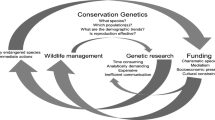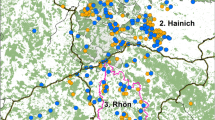Abstract
The European mink is a critically endangered mustelid with only three declining and isolated populations. Based on particular interpretation of genetic studies, the origin of SW population (France and Spain) and its conservation measures were recently questioned, and considered an example of managed relocation. The four published genetic studies show similar results, revealing a bottleneck structure. The SW population was probably established by very few individuals, which can be explained by dispersal of some-long distance migrants or by human introduction. The historical records evidence a long-distance dispersal capacity of the species and the temporal trend expansion in SW Europe is spatially collated with the idea of an expanding population. On contrast, most support for the introduction hypothesis comes from critics to other hypotheses, while it lacks of structure to stand on its own as hypothesis: no ecological barrier preventing natural expansion identified, no reports or reasons for captivity breeding or translocation programs, and lacks of supporting documents among others. Arguing shifting baseline syndrome in European mink conservation has weak basis and can result perilously misleading for a species in the brink of extinction.
Similar content being viewed by others
References
Balmori A, Santos I, Carbonell R (2015) El visón americano Neovison vison (Scheber 1777) en España: posibles causas de su expansión e interacción con otros mamíferos semiacuáticos. Ecosistemas 24:4–11
Beauclerc KB, Bowman J, Schulte-Hostedde I (2013) Assesing the cryptic invasion of a domestic conspecific: American mink in their native range. Ecol Evol 3:2296–2309
Bonesi L, Palazon S (2007) The American mink in Europe: status, impact, and control. Biol Conserv 134:470–483
Bowman J, Jaeger JAG, Fahrig L (2002) Dispersal distance of mammals is proportional to home range size. Ecology 83:2049–2055
Brehm AE, Haacke W, Pechuël-Loesche E, Schmidtlein R (1895) The animals of the word. Brehm’s life of animals; a complete natural history for popular home instruction and for the use of schools. AN Marquis & Co., Chicago
Cabria MT, González EG, Gómez-Moliner BJ, Michaux JR, Skumatov D, Kranz A, Fournier P, Palazón S, Zardoya R (2015) Patterns of genetic variation in the endangered European mink (Mustela lutreola, 1761). BMC Evol Biol 15:141. doi:10.1186/s12862-015-0427-9
Carbonell R (2015) Managing Spanish European mink populations: moving from a precautionary approach towards knowledge-based management. J Nat Conserv 25:58–61
Clavero M (2014) Shifting baselines and the conservation of non-native species. Conserv Biol 28:1434–1436
Clavero M (2015) Non-native species as conservation priorities: response to Díez-León et al. Conserv Biol 29:957–959
Davison A, Griffiths HI, Brookes RC, Maran T, Macdonald DW, Sidorovich VE, Kitchener AC, Irizar I, Villate I, González-Esteban J, Ceña JC, Ceña A, Moya I, Miñano SP (2000) Mitochondrial DNA and paleontological evidence for the origins of endangered European mink, Mustela lutreola. Anim Conserv 4:345–355
de Sélys-Longchamps E (1839) Estudies de micromamalogie. Paris
Díez-León M, Miranda R, Ariño AH, Galicia D (2015) Setting priorities for existing conservation needs of crayfish and mink. Conserv Biol 29:599–601
Garin I, Zuberogoitia I, Zabala J, Aihartza J, Clevenger A, Rallo A (2002) Home range of European mink Mustela lutreola in southwestern Europe. Acta Theriol 47:55–62
Gómez A, Oreca S, Põdra M, Sanz B, Palazón S (2011) Expansión del visón europeo Mustela lutreola (Linnaeus, 1761) hacia el este de su área de distribución en España: primeros datos en Aragón. Galemys 23:37–45
Heptner VG, Naumov NP, Yurgenson PB, Sludsky AA, Chirkova AF, Bannikov AG (1967) Mammals of the USSR. Part 2, vol 1. Vysshaya Shkola, Moscow (in Russian)
Lodé T, Peltier D (2005) Genetic neighbourhood and effective population size in the endangered European mink Mustela lutreola. Biodivers Conserv 14:251–259
Maran T (2007) Conservation biology of the European mink, Mustela lutreola (Linnaeus 1761): decline and causes of extinction. Tallinn University Dissertations on Natural Sciences, vol 15. TLÜ Kirjastus, Tallinn
Maran T, Skumatov D, Palazón S, Gomez A, Põdra M, Saveljev A, Kranz A, Libois R, Aulagnier S (2011) Mustela lutreola. The IUCN red list of threatened species. Version 2014.3. www.iucnredlist.org. Accessed 27 July 2015
Maran T, Põdra M, Fournier P (2014) Mission report: European mink—status in Romania. May 7–15, 2014. Species conservation foundation Looduskaitsesihtasutus. Tallinn
Michaux JR, Libois R, Hardy OJ, Justy F, Fournier P, Kranz A, Cabria M, Davison A, Rosoux R (2005) Conservation genetics and population history of the threatened European mink Mustelalutreola, with an emphasis on the west European population. Mol Ecol 14:2373–2388
Novikov GA (1939) The European mink. Izd.LeningradskogoGos, Leningrad (in Russian)
Palazón S, Ruiz-Olmo J (1998) A preliminary study of the behaviour of the European mink (Mustela lutreola) in Spain, by mean of radiotracking. In: Dunstone N, Gorman ML (eds) Behaviour and ecology of riparian mammals. Cambridge University Press, New York, pp 93–106
Papworth SK, Rist J, Coad L, Milner-Gulland EJ (2009) Evidence for shifting baseline syndrome in conservation. Conserv Lett 2:93–100
Peltier D, Lodé T (2003) Molecular survey of genetic diversity in the endangered European mink Mustela lutreola. C.R. Biologies 325:S49–S53
Põdra M, Gómez A, Palazón S (2013a) Do American mink kill European mink? Cautionary message for future recovery efforts. Eur J Wildl Res 59:431–440
Põdra M, Maran T, Sidorovich VE, Johnson PJ, Macdonald DW (2013b) Restoration programmes and the development of a natural diet: a case study of captive-bred European mink. Eur J Wildl Res 59:93–104
Põdra M, Oreca S, Pinedo J, Zuberogoitia I, Galdós I, González J, López JR, Escudero M, Benavides D, Gómez A (2014) Nuevos enfoques en la conservación del visón europeo en España. Acción A.1: Comprobación de la efectividad de las metodologías de detección y de captura del visón europeo y del visón americano. Primer Seminario Técnico Life-LutreolaSpain. Lifelutreola Life13Nat/ES/001171. Donostia, San Sebastian 18 de diciembre 2014. http://lifelutreolaspain.com/sites/default/files/agenda/podra_m_life_lutreola_spain_2014_efectividad_metodologias_captura._accion_a1_0.pdf. Accessed 1 Dec 2015
Richardson MD, Ricciardi A (2013) Misleading criticism of invasion science: a field guide. Divers Distrib 19:1461–1467
Rodríguez de Ondarra PM (1955) Hallazgo, en Guipúzcoa, de un mamífero no citado en la “Fauna Ibérica” de Cabrera: El “Putorius lutreola”. Munibe 7:201–207
Rubetskaja, Tserbakov, Zeidel (1933) On biology of European mink (Mustela lutreola lutreola) in Moscow zoo. Mosc Bull Zoos, 10 (in Russian)
Sommer R, Benecke N (2001) Subfossil records of the European Mink Mustela lutreola (1761) from the Holocene and their importance for European faunal history. Mamm Biol 66:40–41
Van Bree PJH (1961) On a subfossil skull of Mustela lutreola (Mammalia, Carnivora), found at Vlaardingen, the Netherlands. Zoologischer Anzeiger 166:242–244
Youngman PH (1982) Distribution and the systematics of the European mink Mustela lutreola Linnaeus 1761. Acta Zool Fenn 166:1–48
Zabala J, Zuberogoitia I, Martínez JA (2004) The historical and current distribution of the Iberian population of European mink (Mustela lutreola). Lutra 47:101–112
Zabala J, Zuberogoitia I, González-Oreja JA (2010) Estimating costs and outcomes of invasive American mink (Neovison vison) management in continental areas: a framework for evidence based control and eradication. Biol Invasions 12:2999–3012
Zuberogoitia I, Zalewska H, Zabala J, Zalewski A (2013) The impact of river fragmentation on the population persistence of native and alien mink: an ecological trap for the endangered European mink. Biodivers Conserv 22:169–186
Acknowledgments
Thanks to Alexandra Farrell for the linguistic revision.
Author information
Authors and Affiliations
Corresponding author
Additional information
Communicated by David Hawksworth.
Rights and permissions
About this article
Cite this article
Zuberogoitia, I., Põdra, M., Palazón, S. et al. Misleading interpretation of shifting baseline syndrome in the conservation of European mink. Biodivers Conserv 25, 1795–1800 (2016). https://doi.org/10.1007/s10531-016-1156-0
Received:
Accepted:
Published:
Issue Date:
DOI: https://doi.org/10.1007/s10531-016-1156-0




